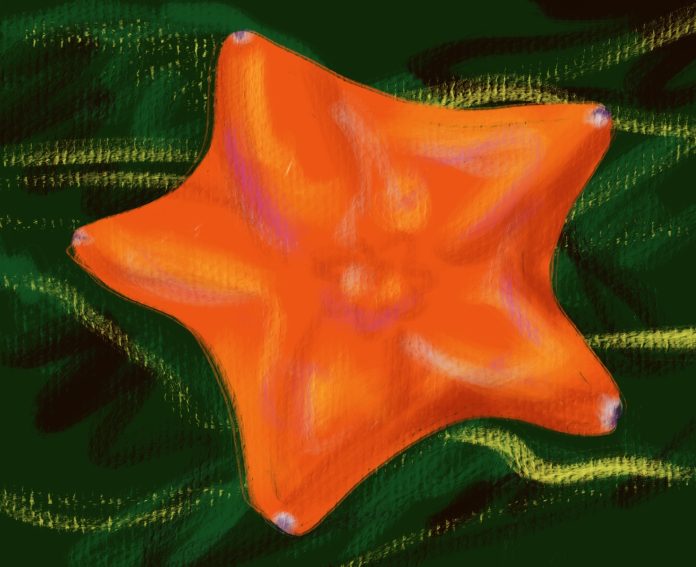Eric Kwon
Science & Technology Editor
The Bat Star can be found among rocks, sandy bottoms, and surf grass, and ranges from intertidal zones to subtidal zones 300 meters deep. It mostly lives along the United States (U.S.) Pacific coast, encompassing a distance from Alaska all the way to Baja California in Mexico, which includes Santa Barbara. Due to their extensive territorial zone and plentiful numbers, it would not be uncommon to see this sea star (a.k.a. “starfish”) in intertidal zones along the beach.
Unlike many other sea stars, the Bat Star comes in a variety of unique colors, including: red, orange, yellow, brown, green and purple. For that reason, it may be difficult to see the patiria miniata as one species. In addition to their diverse hues, the Bat Star can also be seen with a different number of arms. Though they usually have five arms, they can have anywhere from four to nine.
The Bat Star varies in comparison to its gangly, spiny sea star cousins, and instead boasts a radius of about four inches, with short, triangular arms. Their skin is covered in a gill-like substance, making it seem fuzzy. Interestingly, the sea star’s arms seem to have webbing in between them, like a bat’s wing, and this is where the Bat Star gets its name.
In terms of their diet, the Bat Star acts as a scavenger. As an important part of the ecosystem, it cleans dead animals and algae from the ocean floor, which in turn allows for future sea life to flourish. When it cannot scavenge, it eats opportunistically, meaning tunicate worms, other sea stars, and algae. On the other hand, its main predators are other sea stars, mollusks, and crustaceans. Akin to octopi in a way, the Bat Star can avoid being eaten by secreting chemicals to stimulate escape responses in other animals.
Though this particular species of sea star is regarded as the most abundant of its kind along the West Coast, their safety is not guaranteed. There have been links connecting warming ocean temperatures (due to climate change) with sea star wasting. The disease is able to cause mass mortality very fast, and what makes it even more alarming is that there is little knowledge known about the phenomenon.
With reproduction, like other sea stars, the Bat Star can reproduce by both asexual and sexual means. Via asexual reproduction, the part of the parent star breaks off and forms into a new individual sea star, though it is a direct genetic clone from the parent star. The Bat Star engages in sexual reproduction year-round, but generally in the late summer, where both the male and female sea stars will release sperm and eggs from their arms and into the water. The growth period can take a month for the Bat Star to reach maturity, in which the Bat Star will keep safe by holding them under their bodies or keeping them between their arms until they hatch.
The most fascinating fact about the Bat Star is its symbiotic relationship with polychaete worms. These worms are typically found on the Bat Star’s arm grooves or mouth cavities, where leftover bits and pieces of food are left for the worms to eat. They do not seem to harm or bother the Bat Star in any way, and the Bat Star leaves these polychaete worms happily munching away despite that they do not gain any particular benefits.
The Bat Star, though plentiful, occupies a curious space in ocean life. They can be found living in different tidal regions, and it lives in content as a scavenger. The Bat Star would likely be a common sight on campus, laying around rocks after a fresh tidal wash, squirming around to eat on bits of algae — it is only a matter of time before you stumble upon one.

















